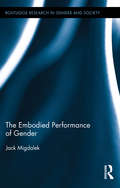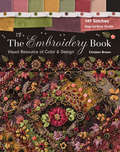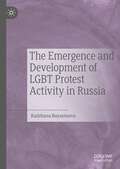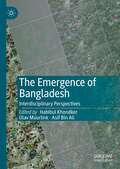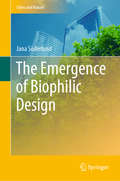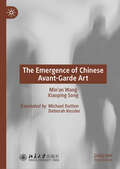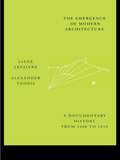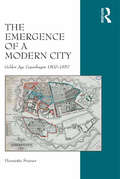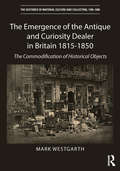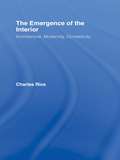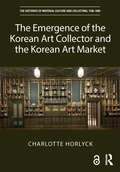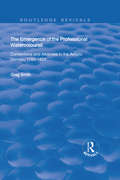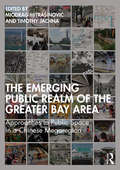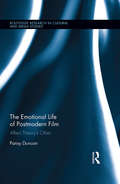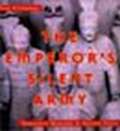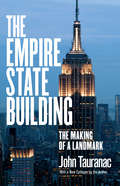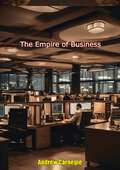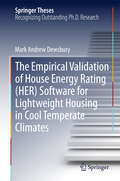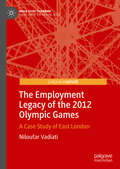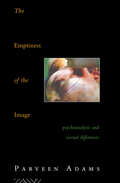- Table View
- List View
The Embodied Performance of Gender (Routledge Research in Gender and Society)
by Jack MigdalekNorms of embodied behaviour for males and females, as promoted in mainstream Western public arenas of popular culture and the everyday, continue to work, overtly and covertly, as definitive and restrictive barriers to the realm of possibilities of embodied gender expression and appreciation. They serve to disempower and marginalize those not inclined to embody according to such dichotomous models. This book explores the ramifications of the way our gendered, sexed and culturally constructed bodies are situated toward notions of difference and highlights the need to safeguard the social and emotional well-being of those who do not fit comfortably with dominant norms of masculine/feminine behaviour, as deemed appropriate to biological sex. The book interrogates gender inequitable machinations of education and performance arts disciplines by which educators and arts practitioners train, teach, choreograph, and direct those with whom they work, and theorizes ways of broadening personal and social notions of possible, aesthetic, and acceptable embodiment for all persons, regardless of biological sex or sexual orientation. The author’s own struggles as a performance artist, educator, and person in the everyday, as well as the findings of empirical fieldwork with educators, performance arts practitioners, and high school students, are employed to illustrate and advocate the need for self reflexive scrutiny of existing and hidden inequities regarding the embodiment of gender within one’s own habitual perspectives, taste, and practices.
The Embroidery Book: Visual Resource of Color & Design
by Christen Brown“A spectacular encyclopedia of embroidery, sharing valuable techniques passed down through the generations . . . you’ll wonder how you ever worked without it.” —Sew MagazineEnjoy the tranquility of slow stitching with this step-by-step, visual guide to 149 embroidery stitches, motifs, and extras. Go beyond basic color theory–robust color charts take the guesswork out of choosing thread, silk ribbon, buttons, beads, and trims. Then take your embroidery to the next level with luxurious seam treatments and stunning stand-alone designs. Bestselling author Christen Brown’s traditional and contemporary techniques are showcased in a colorful gallery of crazy-quilted projects.“An overview of embroidery stitches and techniques as well as inspiration for embroidery projects . . . She dissects several of her pieces, summarizing the color palette, decorative elements, and stitches used.” —Library Journal
The Emergence and Development of LGBT Protest Activity in Russia
by Radzhana BuyantuevaThis book draws on social movement theories and rich empirical data to analyze LGBT protest activity in Russia. It offers a critical examination of the conditions under which LGBT protest activity arises and declines in authoritarian states - including state repression and socio-political discrimination of LGBT people; policy changes that negatively affect the LGBT community; and the motivations of the activists themselves. The author argues that a combination of political opportunity structures, resources, and activists’ perceptions establish necessary conditions for protesting. If any of these factors are negatively affected, then LGBT activists would not be motivated to protest. The volume concludes with a discussion of the implications of Russian LGBT activism in hostile conditions. This book will be of interest to scholars engaged in human rights, social movement studies, gender studies, LGBT rights, and post-Soviet politics and societies.
The Emergence of Bangladesh: Interdisciplinary Perspectives
by Habibul Khondker Olav Muurlink Asif Bin AliThe Emergence of Bangladesh analyses and celebrates the first 50 years of Bangladesh as a nation, bringing insights from key scholars in Bangladeshi studies to an international audience, as well as ‘bringing home’ to a domestic audience the work of some of the nation’s greatest intellectual exports, the Bangladeshi scholars who have made a mark in their field of study in academia. The book offers unique coverage of the battlegrounds on which the founding of the new nation was fought, including language, power and religion, and provides unique insight into some of the hot spots that continue to shape the development of the nation: the issues of gender, culture, ethnicity, governance, the economy and the army. Those with an interest in understanding the past or present Bangladesh will find this a trove of frank and readable analysis.
The Emergence of Biophilic Design (Cities and Nature)
by Jana SöderlundThis book addresses the emergence of biophilic design, a form of design that looks at people’s intrinsic connection with nature. There is no denying that biophilic design is rapidly expanding globally as an effective response to pressing issues in urban areas and built environments. From being a term few had heard of in 2012, when the author’s research began, to one that is currently trending in a broad range of disciplines, the story of its emergence has never been properly told. The story of the emergence of biophilic design is the story of a social movement and how a gathering of people with a common interest and passion can spark a global trend. The book and the stories within are not only engaging but also informative and educational, offering readers an in-depth understanding of what biophilic design is all about, and how to promote its implementation in their own built environment. Hopefully, they will inspire people to act, to campaign and to implement initiatives in their urban environment, with the confidence that they are capable of making a difference. The author spent three years researching the emergence of biophilic design, and why and how it was driven by certain people who championed the concept. Part of the author’s research involved a three-month tour of ten North American cities, during which she interviewed 26 key players. These people ranged from community leaders, landscape architects, and academics, to the CEOs of NGOs and government leaders. The result is a collection of stories that illustrate the evolution of biophilic design, and how it was frequently born from a passion for, belief in and love of nature, as well as a response to an urban crisis.
The Emergence of Chinese Avant-Garde Art
by Min'an Wang Xiaoping SongThis book provides a historical analysis of the avant-garde art movement in China in the 1980s. This art movement is the product of China's reform and opening up, during which time a small number of Chinese artists understood the western modernist art movement, and they started their avant-garde art experiment in combination with the actual situation of China. This avant-garde art experiment completely broke all the artistic styles in Chinese history, and it caused a huge shock. After about a decade of radical attempts, it began to form its own position in China. This book discusses its birth background, its dominant artists and works, its theme and interest, and its final decline. This is not only a work of art history, but also a work of cultural history with strong sociological analysis. This book is beautiful in writing, detailed in analysis and highly readable. It is a very suitable book for those who want to know avant-garde art and Chinese since the 1980s.
The Emergence of Cinematic Time: Modernity, Contingency, the Archive
by Mary Ann DoaneHailed as the permanent record of fleeting moments, the cinema emerged at the turn of the nineteenth century as an unprecedented means of capturing time--and this at a moment when disciplines from physics to philosophy, and historical trends from industrialization to the expansion of capitalism, were transforming the very idea of time. In a work that itself captures and reconfigures the passing moments of art, history, and philosophy, Mary Ann Doane shows how the cinema, representing the singular instant of chance and ephemerality in the face of the increasing rationalization and standardization of the day, participated in the structuring of time and contingency in capitalist modernity. At this book's heart is the cinema's essential paradox: temporal continuity conveyed through "stopped time," the rapid succession of still frames or frozen images. Doane explores the role of this paradox, and of notions of the temporal indeterminacy and instability of an image, in shaping not just cinematic time but also modern ideas about continuity and discontinuity, archivability, contingency and determinism, and temporal irreversibility. A compelling meditation on the status of cinematic knowledge, her book is also an inquiry into the very heart and soul of modernity.
The Emergence of Modern Architecture: A Documentary History, from 1000 to 1810
by Liane Lefaivre Alexander TzonisA cognitive history of the emergence of modern architecture. Cutting across disciplinarian and institutional divisions as we know them today, this book reconstructs developments within the framework of a cognitive history of the past. Modern is here taken to mean the radical re-thinking of architecture from the end of the tenth century in Europe to the end of the eighteenth century. Among the key debates that mark the period are those that oppose tradition to innovation, canon to discovery, geometrical formality to natural picturesqueness, the functional to the hedonistic.
The Emergence of a Modern City: Golden Age Copenhagen 1800–1850
by Henriette SteinerThis book is an exploration of how urban life in Copenhagen, in the period known as the Golden Age (c. 1800 to 1850), was experienced and structured socially, institutionally, and architecturally. It draws on a broad historical source material - spanning urban anecdotes, biography, philosophy, literature, and visual culture - to do so. The book argues that Copenhagen emerged as a modern city at this time, despite the fact that the Golden Age never witnessed the appearance of the main characteristics of the modernisation of cities associated with industrialisation, such as street lighting, sewer systems, and railroads. The book outlines the historical and topographical context of Copenhagen in the Golden Age with a special focus on the works of the most prominent architect of the period, C.F. Hansen. The characterisation of the city is complemented by investigations into writings of three citizens: the philosopher Soren Kierkegaard, the novelist Thomasine Gyllembourg, and the criminal Ole Kollerod, who all take an interest in the city's institutional and urban structures as well as their own place in it. From these different sources, a picture is painted of urban life and thought at a time when the city began to take on characteristics of ambiguity and alienation in European thinking, while at the same time the city itself retained some pre-modern motifs of a symbolic order. This transformation is set in a larger process of cultural re-orientation, from traditional Baroque culture to what might be termed Romantic culture. The book reconsiders the significance of this transformation for the emergent order of the modern European city in the nineteenth century and thus of the very foundation on which our own urban culture rests.
The Emergence of the Antique and Curiosity Dealer in Britain 1815-1850: The Commodification of Historical Objects (The Histories of Material Culture and Collecting, 1700-1950)
by Mark WestgarthRather than the customary focus on the activities of individual collectors, The Emergence of the Antique and Curiosity Dealer in Britain 1815–1850: The Commodification of Historical Objects illuminates the less-studied roles played by dealers in the nineteenthcentury antique and curiosity markets. Set against the recent ‘art market turn’ in scholarly literature, this volume examines the role, activities, agency and influence of antique and curiosity dealers as they emerged in the opening decades of the nineteenth century. This study begins at the end of the Napoleonic Wars, when dealers began their wholesale importations of historical objects; it closes during the 1850s, after which the trade became increasingly specialised, reflecting the rise of historical museums such as the South Kensington Museum (V&A). Focusing on the archive of the early nineteenth-century London dealer John Coleman Isaac (c.1803–1887), as well as drawing on a wide range of other archival and contextual material, Mark Westgarth considers the emergence of the dealer in relation to a broad historical and cultural landscape. The emergence of the antique and curiosity dealer was part of the rapid economic, social, political and cultural change of early nineteenth-century Britain, centred around ideas of antiquarianism, the commercialisation of culture and a distinctive and evolving interest in historical objects. This book will be of interest to scholars in art history, histories of collecting, museum and heritage studies and nineteenth-century culture.
The Emergence of the Interior: Architecture, Modernity, Domesticity
by Charles RiceTaking a radical position counter to many previous histories and theories of the interior, domesticity and the home, The Emergence of the Interior considers how the concept and experience of the domestic interior have been formed from the beginning of the nineteenth century. It considers the interior's emergence in relation to the thinking of Walter Benjamin and Sigmund Freud, and, through case studies, in architecture's trajectories toward modernism. The book argues that the interior emerged with a sense of 'doubleness', being understood and experienced as both a spatial and an image-based condition. Incorporating perspectives from architecture, critical history and theory, and psychoanalysis, The Emergence of the Interior will be of interest to academics and students of the history and theory of architecture and design, social history, and cultural studies.
The Emergence of the Korean Art Collector and the Korean Art Market (The Histories of Material Culture and Collecting, 1700-1950)
by Charlotte HorlyckArticulating the shifting interests in Korean art and offering new ways of conceiving the biases that initiated and impacted its collecting, this book traces the rise of the modern Korean art market from its formative period in the 1870s through to its peak and subsequent decline in the 1930s.The discussion centres on the collecting of Koryŏ celadon ceramics as they formed the focal point of commercial exchanges of Korean artefacts and explores how their acquisition and ownership formed part of the complex power relationship that played out between the Koreans, Japanese, Americans, and Europeans. Drawing on a wide range of primary sources, the volume analyses collectors’ acquisition practices, arguing that their fascination with ceramics from the Koryŏ kingdom (918–1392) was shaped not only by the aesthetic appeal of the objects but also by biased perceptions of the Korean peninsula, its history, and people.The book will be of interest to scholars working in art history, social history, cultural history, Korean studies, collection studies, museum studies, Korean history, and Asian studies.
The Emergence of the Professional Watercolourist: Contentions and Alliances in the Artistic Domain, 1760–1824 (Routledge Revivals)
by Greg SmithThis title was first published in 2002: Draw ing on extensive primary research, Greg Smith describes the shifting cultural identities of the English watercolour, and the English watercolourist, at the end of the eighteenth and the beginning of the nineteenth century. His convincing narrative of the conflicts and alliances that marked the history of the medium and its practitioners during this period includes careful detail about the broader artistic context within which watercolours were produced, acquired and discussed. Smith calls into question many of the received assumptions about the history of watercolour painting. His account exposes the unsatisfactory nature of the traditional narrative of watercolour painting’s development into a ’high’ art form, which has tended to offer a celebratory focus on the innovations and genius of individual practitioners such as Turner and Girtin, rather than detailing the anxieties and aspirations that characterized the ambivalent status of the watercolourist. The Emergence of the Professional Watercolourist is published with the assistance of the Paul Mellon Foundation.
The Emerging Asian City: Concomitant Urbanities & Urbanisms
by Vinayak BharneThe Asian urban landscape contains nearly half of the planet’s inhabitants and more than half of its slum population living in some of its oldest and densest cities. It encompasses some of the world’s oldest civilizations and colonizations, and today contains some of the world’s fastest growing cities and economies. As such Asian cities create concomitant imagery – polarizations of poverty and wealth, blurred lines between formality and informality, and stark juxtapositions of ancient historic places with shimmering new skylines. This book embraces the complexity and ambiguity of the Asian urban landscape, and surveys its bewildering array of multifarious urbanities and urbanisms. Twenty-four essays offer scholarly reflections and positions on the complex forces and issues shaping Asian cities today, looking at why Asian cities are different from the West and whether they are treading a different path to their futures. Their combined narrative – spanning from Turkey to Japan and Mongolia to Indonesia - is framed around three sections: Traditions reflects on indigenous urbanisms and historic places, Tensions reflects on the legacies of Asia’s East–West dialectic through both colonialism and modernism and Transformations examines Asia’s new emerging utopias and urban aspirations. The book claims that the histories and destinies of cities across various parts of Asia are far too enmeshed to unpack or oversimplify. Avoiding the categorization of Asian cities exclusively by geographic location (south-east, Middle East), or the convenient tagging of the term Asian on selective regional parts of the continent, it takes a broad intellectual view of the Asian urban landscape as a 'both…and' phenomenon; as a series of diverse confluences – geographic, historic and political – extending from the deserts of the Persian Gulf region to the Pearl River Delta. Arguing for Asian cities to be taken seriously on their own terms, this book represents Asia – as a fount of extraordinary knowledge that can challenge our fundamental preconceptions of what cities are and ought to be.
The Emerging Public Realm of the Greater Bay Area: Approaches to Public Space in a Chinese Megaregion
by Miodrag Mitrašinović; Timothy JachnaThrough illustrated case studies and conceptual re-framings, this volume showcases ongoing transformations in public space, and its relationship to the public realm more broadly in the world’s most populous urban megaregion—the Greater Bay Area of southeastern China—projected to reach eighty million inhabitants by the year 2025. This book assembles diverse approaches to interrogating the forms of public space and the public realm that are emerging in the context of this region’s rapid urban development in the last forty years, bringing together authors from urbanism, architecture, planning, sociology, anthropology and politics to examine innovative ways of framing and conceptualizing public space in/of the Greater Bay Area. The blend of authors’ first-hand practical experiences has created a unique cross-disciplinary book that employs public space to frame issues of planning, political control, social inclusion, participation, learning/education and appropriation in the production of everyday urbanism. In the context of the Greater Bay Area, such spaces and practices also present opportunities for reconfiguring design-driven urban practice beyond traditional interventions manifested by the design of physical objects and public amenities to the design of new social protocols, processes, infrastructures and capabilities. This is a captivating new dimension of urbanism and critical urban practice and will be of interest to academics, students and practitioners interested in urbanization in China.
The Emotional Life of Postmodern Film: Affect Theory's Other (Routledge Research in Cultural and Media Studies)
by Pansy DuncanEmotion and Postmodernism: is it possible to imagine an odder couple, stranger bedfellows, less bad company? The Emotional Life of Postmodern Film brings this unlikely pair into sustained dialogue, arguing that the interdisciplinary body of scholarship currently emerging under the rubric of "affect theory" may be unexpectedly enriched by an encounter with the field that has become its critical other. Across a series of radical re-reappraisals of canonical postmodern texts, from Fredric Jameson's Postmodernism to David Cronenberg's Crash, Duncan shows that the same postmodern archive that has proven resistant to strongly subject-based and object-oriented emotions, like anger and sadness, proves all too congenial to a series of idiosyncratic, borderline emotions, from knowingness, fascination and bewilderment to boredom and euphoria. The analysis of these emotions, in turn, promises to shake up scholarly consensus on two key counts. On the one hand, it will restructure our sense of the place and role of emotion in a critical enterprise that has long cast it as the stodgy, subjective sister of a supposedly more critically interesting and politically productive affect. On the other, it will transform our perception of postmodernism as a now-historical aesthetic and theoretical moment, teaching us to acknowledge more explicitly and to name more clearly the emotional life that energizes it.
The Emperor and the World
by Alicia WalkerByzantine imperial imagery is commonly perceived as a static system. In contrast to this common portrayal, this book draws attention to its openness and responsiveness to other artistic traditions. Through a close examination of significant objects and monuments created over a 350-year period, from the ninth to the thirteenth century, Alicia Walker shows how the visual articulation of Byzantine imperial power not only maintained a visual vocabulary inherited from Greco-Roman antiquity and the Judeo-Christian tradition, but also innovated on these artistic precedents by incorporating styles and forms from contemporary foreign cultures, specifically the Sasanian, Chinese, and Islamic worlds. In addition to art and architecture, this book explores historical accounts and literary works as well as records of ceremonial practices, thereby demonstrating how texts, ritual, and images operated as integrated agents of imperial power. Walker offers new ways to think about cross-cultural interaction in the Middle Ages and explores the diverse ways in which imperial images employed foreign elements in order to express particularly Byzantine meanings.
The Emperor’s Silent Army: Terracotta Warriors of Ancient China
by Jane O'ConnorDescribes the archaeological discovery of thousands of life-sized terracotta warrior statues in northern China in 1974, and discusses the emperor who had them created and placed near his tomb.
The Empire State Building: The Making of a Landmark
by John TauranacThe Empire State Building is the landmark book on one of the world's most notable landmarks. Since its publication in 1995, John Tauranac's book, focused on the inception and construction of the building, has stood as the most comprehensive account of the structure. Moreover, it is far more than a work in architectural history; Tauranac tells a larger story of the politics of urban development in and through the interwar years. In a new epilogue to the Cornell edition, Tauranac highlights the continuing resonance and influence of the Empire State Building in the rapidly changing post-9/11 cityscape.
The Empire of Business
by Andrew CarnegieThis book contains several articles and speeches by Andrew Carnegie, one of the most important industrialists of the end of the 19th and beginning of the 20th century in the United States; the man who would later inspire Napoleon Hill to write "Think and Grow Rich". His ideas on How to win fortune, the importance of wealth, and how young people can succeed, inspired generations. In his philanthropic work, he created and funded a network of public libraries in the United States, and funded places for culture as the Carnegie Hall in New York. A great man, with timeless ideas and wisdom that we can now enjoy.-Print ed.
The Empirical Validation of House Energy Rating (HER) Software for Lightweight Housing in Cool Temperate Climates
by Mark Andrew DewsburyThis book reports on the first empirical validation of "AccuRate," Australia's national benchmark software tool for house energy ratings. The validation was conducted by the University of Tasmania in collaboration with Forest and Wood Products Australia, the Australian Government, the CSIRO and industry partners. The study presented here describes the results of graphical and statistical analysis of variations observed between the measured and simulated data from three different test buildings in Launceston, Tasmania. It shows that, while the AccuRate software is well suited to modeling energy flows, there are discrepancies between the simulated and measured temperatures of the test buildings. Moreover, it highlights possible connections between the discrepancies in all zones and the outside air temperature, wind speed, global and diffuse solar radiation, and possibly the ground model. Beyond its contribution to further investigations into the ongoing improvement and calibration of the Australian NatHERS-supported AccuRate software, this book also meticulously describes the methodology used in conducting the research, which is expected to pave the way for further studies of this type.
The Employment Legacy of the 2012 Olympic Games: A Case Study of East London (Mega Event Planning)
by Niloufar VadiatiThis book offers a detailed account of the employment promises made to local East Londoners when the Summer Olympic Games 2012 were awarded to London, as well as an examination of how those promises had morphed into the Olympic Labor market jamboree from which local communities were excluded.Regarding the global job market of London, this study provides a nuanced empirical view on how the world’s biggest mega event was experienced and endured in terms employment by its immediate hosts, in one of the UK’s poorest, most ethnically complex, and transient areas. The data has been collected through ethnographic observation and interviews with local residents, and expert interviews with the Olympic delivery professionals. Using Bourdieusian theory of contested capital, the findings provide an important bearing on the reproduction of inequality in the local labor markets of Olympic host cities.
The Empress of Art: Catherine the Great and the Transformation of Russia
by Susan JaquesRuthless and passionate, Catherine the Great is singularly responsible for amassing one of the most awe-inspiring collections of art in the world and turning St. Petersburg in to a world wonder. The Empress of Art brings to life the creation of this captivating woman's greatest legacy An art-oriented biography of the mighty Catherine the Great, who rose from seemingly innocuous beginnings to become one of the most powerful people in the world. A German princess who married a decadent and lazy Russian prince, Catherine mobilized support amongst the Russian nobles, playing off of her husband's increasing corruption and abuse of power. She then staged a coup that ended with him being strangled with his own scarf in the halls of the palace, and she being crowned the Empress of Russia. Intelligent and determined, Catherine modeled herself off of her grandfather in-law, Peter the Great, and sought to further modernize and westernize Russia. She believed that the best way to do this was through a ravenous acquisition of art, which Catherine often used as a form of diplomacy with other powers throughout Europe. She was a self-proclaimed "glutton for art" and she would be responsible for the creation of the Hermitage, one of the largest museums in the world, second only to the Louvre. Catherine also spearheaded the further expansion of St. Petersburg, and the magnificent architectural wonder the city became is largely her doing. There are few women in history more fascinating than Catherine the Great, and for the first time, Susan Jaques brings her to life through the prism of art.
The Emptiness of the Image: Psychoanalysis and Sexual Differences
by Parveen AdamsThere has long been a politics around the way in which women are represented, with objection not so much to specific images as to a regime of looking which places the represented woman in a particular relationship to the spectator's gaze. Artists have sometimes avoided the representation of women altogether, but they are now producing images which challenge the regime. How do these images succeed in their challenge ? The Emptiness of the Image offers a psychoanalytic answer. Parveen Adams argues that, despite flaws in some of the details of its arguments, psychoanalytic theory retains an overwhelming explanatory strength in relation to questions of sexual difference and representation. She goes on to show how the issue of desire changes the way we can think of images and their effects. Throughout she discusses the work of theorists, artists and filmmakers such as Helene Deutsch, Catherine MacKinnon, Mary Kelly, Francis Bacon, Michael Powell and Della Grace. The Emptiness of the Image shows how the very space of representation can change to provide a new way of thinking the relation between the text and the spectator. It shows how psychoanalytic theory is supple enough to slide into and transform the most unexpected situations.
The Empty Museum: Western Cultures and the Artistic Field in Modern Japan
by Masaaki MorishitaThis book examines the processes through which public art museums, as modern Western institutions, were introduced to Japan in the late nineteenth century and how they subsequently developed distinctive national characteristics. The author focuses on one of the most distinctive forms of Japanese museums: the 'empty museums' - museums without collections, permanent displays, and curators. Morishita shows how they developed, in relation to social and cultural conditions at certain periods in modern Japanese history, by engaging with a wide range of interdisciplinary theories, in particular, Pierre Bourdieu's field theory and the conceptual framework of transculturation. Japan is used as a case study to show in general terms how the elements of modern Western culture associated with public art museums were introduced and transformed in the local conditions of non-Western regions. With its unique empirical cases and theoretical focus, the book makes a significant contribution to existing literature in the field of museum studies, both in the English-speaking world and in Japan, and will be of interest to scholars and students of sociology, art history, cultural studies and Japanese studies.
